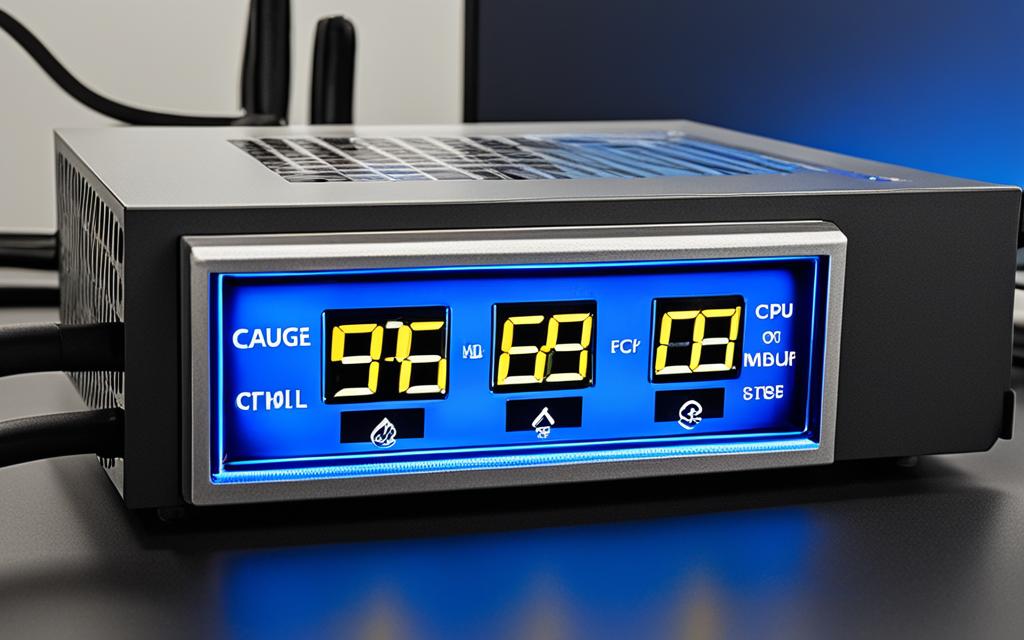Table of Contents
Knowing the best heat levels for CPUs is crucial for both their performance and life span. The CPU is the core of every computer. It works best at temperatures below 80°C (176°F)1. On average, a CPU’s temperature ranges from 40-60 degrees Celsius during regular use. It might reach 80 degrees Celsius when the computer works hard1. It’s important to keep within these ranges to avoid damaging the CPU.
Even though most CPUs can handle up to 100 degrees Celsius1, regularly hitting such high temperatures can shorten their lives. So, understanding and managing your CPU’s temperature is key for its longevity and efficiency.
Key Takeaways
- The safe CPU operating temperature is typically below 80°C (176°F) for optimal performance and longevity.
- During normal workloads, CPUs generally run at temperatures between 40-65°C (104-149°F).
- Intensive workloads or gaming can raise temperatures to between 70-80°C (158-176°F).
- Exceeding temperatures of 90°C can indicate serious problems that may risk CPU damage.
- Continuous monitoring of CPU temperatures is essential for maintaining system stability.
- Modern CPUs often come equipped with thermal throttling features to prevent overheating.
- Manufacturer specifications provide the maximum safe temperature limits for specific CPU models.
Understanding CPU Temperatures
The definition of CPU temperature means how warm a processor gets when used. It shows if a CPU works well and safely. The heat depends on electrical use, how hard it works, and how good the cooling is. High demands or poor cooling can lead to the CPU getting too hot.
What is CPU Temperature?
CPU temperature is key to computer performance. CPUs work best between 40-70 degrees Celsius for everyday tasks. Here are the ideal temperatures for various activities:
| Activity Level | Idle Temperature (°C) | Light Load (°C) | Gaming (°C) | Intensive Tasks (°C) |
|---|---|---|---|---|
| Ideal | 30-40 | 40-60 | 60-85 | 70-95 |
It’s crucial to keep an eye on CPU heat. A CPU getting over 80°C often needs attention. High heat for too long can harm the CPU’s life23.
The Importance of Monitoring CPU Temperature
Checking CPU heat stops performance issues and damage. Good cooling, like enough air flow and quality thermal paste, is vital. For spot checks, infrared thermometers are over 98% accurate. They give quick readings to help manage heat2. When gaming or doing heavy tasks, keeping the CPU cool is key. Heat might hit 70-90°C during these times3.
Normal Operating Temperature for CPUs
It’s vital to know the normal idle temperature for CPUs and how it changes with different workloads. This knowledge helps keep your system running smoothly, especially when heavily used.
Idle Temperature Ranges
Normal idle temperature for CPUs ranges from 30°C to 50°C. Intel CPUs from the Coffee Lake Refresh range, like the Core i5-9600K, often show 28°C to 40°C when idle4. Systems in this temperature range are usually well-cooled.
If the idle temperature is above 50°C, it may suggest problems with airflow or dust accumulation. Such issues could affect cooling performance.
Under Load Temperature Ranges
For CPU temperature under load, safe levels can change a lot depending on the task. Under normal use, CPUs can handle 40°C to 80°C5. While gaming or doing rendering work, 70°C to 85°C is typical6.
The highest safe temperature for many CPUs is about 100°C4. Always keep an eye on temperature levels to maintain performance and avoid overheating. Overheating can seriously affect how your system works.
| Temperature Range | Condition | Remarks |
|---|---|---|
| Idle: 30-50°C | Normal | Indicates good cooling efficiency |
| Idle: >50°C | Warning | Check cooling system and airflow |
| Load: 40-80°C | Normal | Acceptable range for regular tasks |
| Load: 70-85°C | High | Monitor closely, potential thermal throttling |
| Max Load: Up to 100°C | Critical | Immediate action required to avoid failure |
Checking your CPU temperatures often with tools like HWiNFO and Core Temp is crucial. It helps keep your system within safe limits for a long time. For more info on how to monitor these temperatures, visit checking PC temperature465.
What Temperature is Safe for CPU?
To understand what’s safe for a CPU, we need to think about a few things. CPUs have certain CPU safety thresholds. These vary greatly based on their design and the jobs they do. Learning these limits helps avoid the risks of high CPU temperature.
Safety Thresholds for Modern CPUs
Generally, CPUs should stay between 60°C and 80°C. This depends on the model and how it cools7. High-performance CPUs, like those in gaming PCs, can handle up to 90°C under heavy use7. But, it’s best if they stay below 85°C, especially when overclocked often, to avoid damage or slowing down8.
It’s key to watch your CPU’s heat, particularly with tasks like rendering. Aim for 75°C to 80°C for long jobs8. Some find that techniques like undervolting can drop heat by 10°C. Keeping below 70°C with intense apps can make your CPU last longer7.
Performance vs. Safety Debate
There’s a lot of back and forth about performance versus safety. Some people are okay with hitting up to 85°C, while others don’t like going above 80°C. They worry about damage in the long run87. Reports say that running CPUs at 82°C is fine if your cooling is good8.
Even though high running costs can be concerning, temperatures within safe limits shouldn’t cause overheating. Being too worried about temperature might not be needed if your cooling is right. It shows that hands-on experience is very valuable in finding what works87.
| Temperature Range (°C) | Risk Level | Recommended Action |
|---|---|---|
| Below 60 | Low | Normal Operating Conditions |
| 60 – 70 | Moderate | Monitor Regularly |
| 70 – 80 | High | Consider Cooling Solutions |
| 80 – 85 | Critical | Immediate Cooling Required |
| Above 85 | Danger | Shutdown System Immediately |
Signs of Overheating CPUs
Understanding the signs of an overheating CPU is crucial in today’s advanced tech environment. Recognising these symptoms helps prevent further damage and extends your hardware’s life. Look for physical signs such as loud fan noise, unexpected shutdowns, or blue screens. These indicate your CPU is too hot.
Common Symptoms of Overheating
If your cooling fans are noisier, it means they’re working hard to cool down the CPU. Computers that act slowly or freeze might be too hot. This often comes from bad ventilation or old cooling systems. Seeing temperatures over 80°C regularly means your CPU needs immediate attention to avoid harm9.
When to Be Concerned
Watching your system’s performance is key. CPU temperatures between 70°C and 100°C trigger built-in safety measures, shutting it down to avoid damage10. Keeping an eye on these signs helps keep your equipment running well. For tips on monitoring your CPU temperature, check out this resource.
FAQ
What does CPU temperature indicate?
CPU temperature shows how hot the processor gets when it’s being used. It tells us about the processor’s activity and if the cooling methods are working well. Factors such as heavy tasks, poor cooling, and room temperature can change this measure.
How often should I monitor CPU temperature?
You should keep an eye on your CPU’s temperature often. This is crucial during intense work or when the system slows down. If temperatures stay above 80°C regularly, it might mean your cooling needs a boost or other fixes to avoid overheating.
What is the normal idle temperature range for CPUs?
At rest, a good cooling system keeps CPU temperatures between 30°C to 40°C (86°F to 104°F). This range shows the system is running efficiently without much strain.
What temperatures can CPUs handle under load?
Under heavy use, CPUs can usually withstand up to 80°C (176°F). Yet, staying above this might cause issues like thermal throttling or damage. Short increases above this are okay for peak tasks.
What are the safety thresholds for modern CPUs?
Modern CPUs can work safely up to 100°C, but it’s better not to keep them so hot. Continuously high temperatures could shorten their life and affect reliability.
What are the common symptoms of a CPU overheating?
Overheating CPUs might make the fan louder, cause sudden power offs, and blue screen errors. Noticing these early can help fix cooling problems in time.
When should I be concerned about my CPU’s temperature?
If your CPU often goes over 80°C, it’s a sign of trouble, especially with issues like system crashes. Keeping track can help spot heating problems early on.
Source Links
- https://community.spiceworks.com/t/what-is-a-normal-temperature-for-a-cpu-and-how-do-i-keep-it-low/948818 – What is a normal temperature for a CPU and how do I keep it low?
- https://www.noyafa.com/blogs/knowledge-base/good-cpu-temperature – What Is A Good CPU Temperature? A Guide to Keep Your Processor Cool
- https://computercity.com/hardware/processors/normal-cpu-temperatures – Normal CPU Temperatures: Guidelines for Safe & Optimal Performance – ComputerCity
- https://www.buildcomputers.net/cpu-temperature.html – CPU Temperature – What are the Normal and Maximum CPU Temps?
- https://www.linkedin.com/advice/3/what-normal-optimal-ranges-cpu-temperature-different – What are the normal and optimal ranges of CPU temperature for different types of processors?
- https://gadgetmates.com/normal-cpu-gpu-temperatures-for-your-pc – Normal CPU & GPU Temperatures For Your PC – GadgetMates
- https://www.lenovo.com/us/en/glossary/what-is-cpu-temperature/ – Cpu Temperature: What is CPU Temperature?
- https://www.overclock.net/threads/is-it-safe-to-squeeze-100°c-on-a-cpu-like-alder-lake.1798561/ – Is it safe to squeeze 100°C on a CPU like Alder Lake?
- https://www.linkedin.com/advice/0/what-common-causes-symptoms-cpu-overheating-skills-computer-repair – What are the common causes and symptoms of CPU overheating?
- https://techvilleonline.com/is-your-computer-overheating-6-signs-it-is-and-how-to-fix-it/ – Is Your Computer Overheating?: 6 Signs It is And How to Fix It












